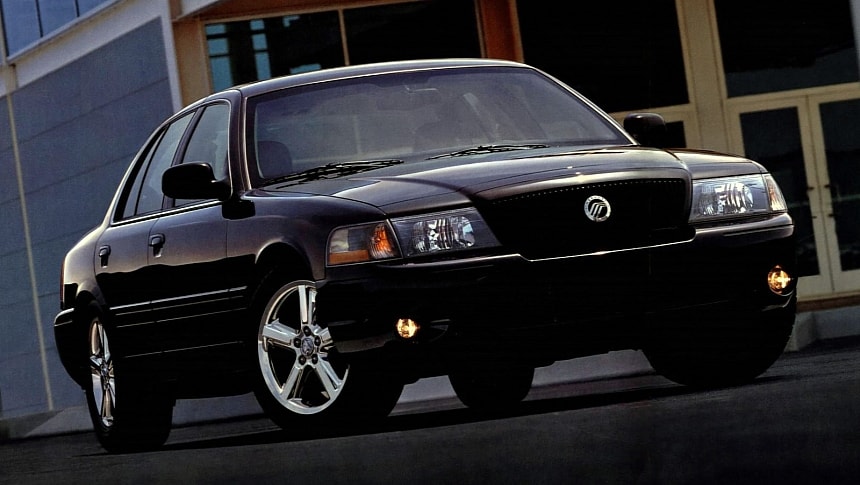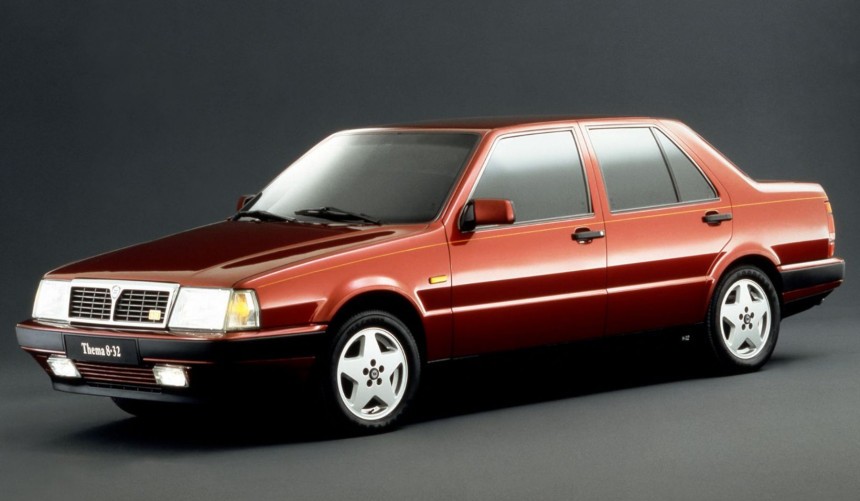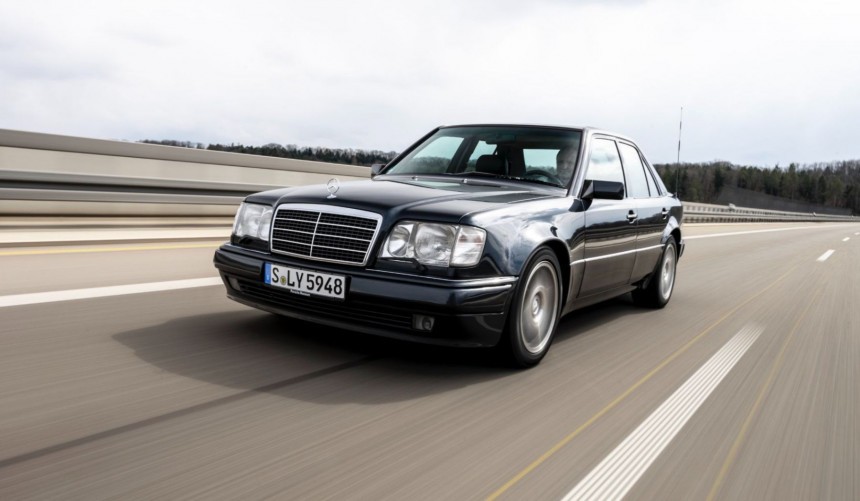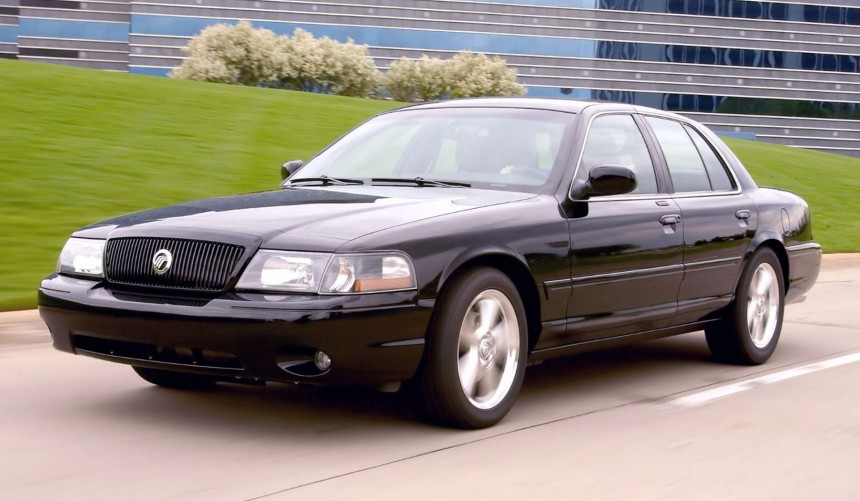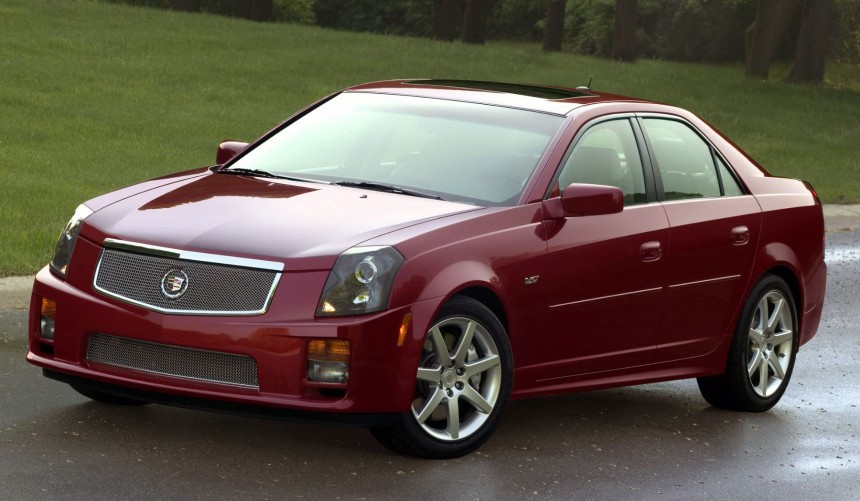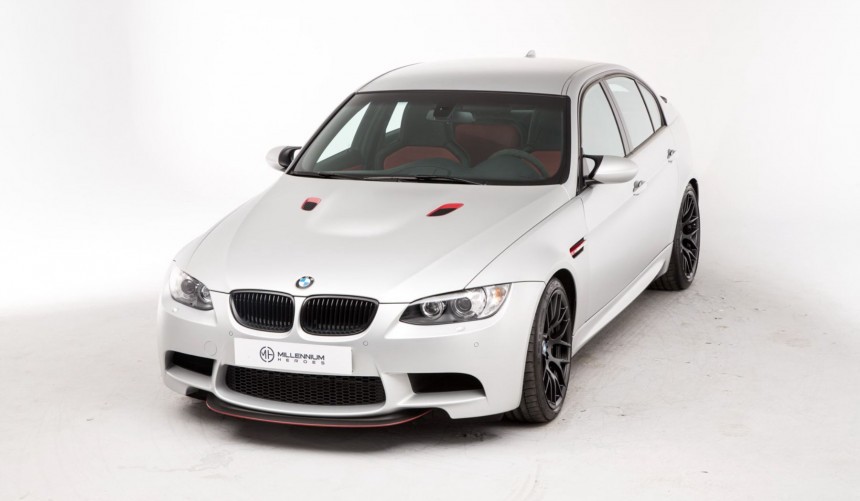From the late 1980s to the late 2000s, manufacturers worldwide made a habit of stuffing powerful, naturally aspirated V8s into their high-performance sedans, and these five are our favorites.
Although it was born in France at the beginning of the 1900s, the V8 engine spread like wildfire throughout the automotive industry from the 1940s onwards, becoming arguably the most famous configuration, particularly among high-performance enthusiasts.
The V8 defined the short-lived golden age of muscle cars on US shores, while elsewhere around the world, it began seeing use in various models, from high-performance sports cars to five-door sedans.
The latter segment often used a toned-down, naturally-aspirated V8 that delivered just enough power to complement comfort, but in the case of the following five sedans, it turned them into high-performance icons.
Throughout its history, Lancia has developed some great cars, but the first-generation Thema wasn't one of them.
An upscale FWD sedan (or wagon) aimed to compete with the Alfa Romeo 164 or the Saab 9000, the Thema was produced from 1984 to 1994, failing to outsell its rivals.
But while it was largely a forgettable series, the Thema had one rebellious performance version that was particularly impressive.
Called 8.32, after the number of cylinders and valves of its engine, this Thema unicorn made waves for hiding a Ferrari V8 under its hood.
Not only was the 8.32 the only Thema that came with a V8, but it received one heavily based on the unit that powered the 308 GTB QV and Mondial Quattrovalvole.
Codenamed Tipo F105L, this 2.9-liter four-valve version of Ferrari's Dino V8 used a cross-plane crankshaft rather than the flat-plane variant used on the above-mentioned Ferraris.
Still a genuine Ferrari V8 (co-developed with Ducati), the F105L made a healthy 212 hp and 210 lb-ft (285 Nm) of torque in non-catalyzed guise - a respectable figure for 1986.
Though not the prettiest nor the most powerful entry on this list, the Thema 8.32 remains a fascinating factory-built, Ferrari-powered sleeper sedan.
For the W124 generation, which became the E-Class in 1993, Mercedes-Benz wanted to create a V8-powered performance version without the help of then-independent AMG.
However, its engineers were busy developing the groundbreaking W140 S-Class, so the manufacturer turned to crosstown sports car experts, Porsche.
In Zuffenhausen, the W124's chassis was widened by about 2 inches (5 cm) to accommodate a revamped suspension system. Then, it received new bumpers, enlarged fenders, and, last but not least, a potent Mercedes-Benz V8.
Codenamed M119, the 5.0-liter naturally-aspirated unit rated at 322 hp and 354 lb-ft (480 Nm) or torque didn't come from the W124 lineup, but rather the R129 500 SL roadster.
Called the "Wolf in Sheep's Clothing" by the motoring press, 1990-1995 500 E (marketed as E 500 since 1993) was able to sprint from zero to 62 mph (100 kph) in 5.5 seconds, which, during the early 1990s, was pretty impressive for a slightly large and heavy, luxury-focused sedan.
Co-developed and fully assembled by Porsche, the 500 E was eventually handed to AMG, who released a limited number of tuned versions called E 60 AMG.
These cars featured 6.0-liter V8s rated at 381 hp and several other enhancements, including an AMG dual exhaust system and 17" alloys borrowed from the 190 E EVO-II.
In an effort to revitalize its image and appeal to younger buyers, Mercury decided to revive the Marauder nameplate used during the 1950s and 1960s for its most potent V8 engines as well as its most impressive land yachts.
Introduced as a five-seat, two-door convertible concept at the 2002 Chicago Auto Show, the third-gen Marauder made it into production several months later as a blacked-out sedan that used a naturally aspirated V8 instead of the concept's supercharged unit.
While it looked much like the Mercury Grand Marquis and the Ford Crown Victoria, the Marauder was actually a bonafide factory-built sleeper.
Powered by the performance-oriented four-valve DOHC version of the 4.6-liter Modular, it had 302 hp on tap as opposed to the 235 hp of the most powerful SOHC variant available on the Grand Marquis.
Able to sprint from zero to 60 mph (97 kph) in 6.9 seconds, the revived Marauder was by no means a sports car killer, but it was unquestionably one of the most surprisingly powerful vehicles that Mercury had released in over three decades.
Moreover, unlike contemporary American performance sedans, it used a good old-fashioned recipe that combined RWD with a 300+ horsepower naturally aspirated V8 and RWD instead of FWD or a supercharged mill with fewer cylinders.
Although it wasn't the resounding success Mercury hoped for and continues to be grossly underrated, the third-gen Marauder remains one of the greatest American-built sleeper sedans.
A year after releasing the Mercedes-Benz E-Class- and BMW 5 Series-rivaling CTS, Cadillac introduced the high-performance CTS-V, which had the AMG- and M-badged versions of its European rivals in its crosshairs.
Of course, since the contemporary M5 and E 63 AMG were both powered by V8s, Cadillac borrowed one from GM siblings Chevy for its high-performance sedan.
Initially, the CTS-V was equipped with the C5 Corvette Z06's 5.7-liter LS6, which was rated at 400 hp and 395 lb-ft (536 Nm) of torque, but from 2006 to the end of production, it received the standard C6's 6.0-liter LS2 that made the same amount of horsepower but 5 lb-ft (7 N⋅m) less torque.
Apart from the potent naturally-aspirated V8s that enabled a 4.6-second sprint from 0 to 60 mph (97 kph), the CTS-V received a revamped suspension system and larger brakes delivered by Italian experts Brembo.
Though it didn't age too well in terms of design, when it comes to performance, the first-gen CTS-V remains one of the most impressive modern-classic, V8-powered sedans out there.
Since the first iteration made its debut in 1985, the M3 has become BMW's most successful performance model.
In 2007, it was time for the fourth generation, which could be had in four-door sedan guise once again, and for the first time (and so far, last), the M3 received a V8.
A naturally-aspirated all-aluminum 4.0-liter which went on to win the International Engine of the Year award five years in a row, the S65 delivered 414 hp and 295 lb-ft (400 Nm) of torque.
That made the four-door M3 (E90) one of the most exciting high-performance sedans of the 2000s.
Nonetheless, BMW didn't stop there, and in 2011, it launched the limited-series M3 CRT (Carbon Racing Technology). As the name implies, it came with a series of carbon fiber components, as well as the enlarged 4.4-liter, 444-hp version of the S65.
With less weight and more power, each of the 67 CRTs built in 2011 could sprint to 62 mph (100 kph) from a standstill in 4.4 seconds, but more importantly, they enhanced the driving experience to a realm bordering perfection.
Although (or because) it broke with the six-cylinder tradition, the E90 M3 and M3 CRT continue to hold a special place in the hearts of many BMW enthusiasts.
The V8 defined the short-lived golden age of muscle cars on US shores, while elsewhere around the world, it began seeing use in various models, from high-performance sports cars to five-door sedans.
The latter segment often used a toned-down, naturally-aspirated V8 that delivered just enough power to complement comfort, but in the case of the following five sedans, it turned them into high-performance icons.
Lancia Thema 8.32
An upscale FWD sedan (or wagon) aimed to compete with the Alfa Romeo 164 or the Saab 9000, the Thema was produced from 1984 to 1994, failing to outsell its rivals.
But while it was largely a forgettable series, the Thema had one rebellious performance version that was particularly impressive.
Called 8.32, after the number of cylinders and valves of its engine, this Thema unicorn made waves for hiding a Ferrari V8 under its hood.
Not only was the 8.32 the only Thema that came with a V8, but it received one heavily based on the unit that powered the 308 GTB QV and Mondial Quattrovalvole.
Codenamed Tipo F105L, this 2.9-liter four-valve version of Ferrari's Dino V8 used a cross-plane crankshaft rather than the flat-plane variant used on the above-mentioned Ferraris.
Still a genuine Ferrari V8 (co-developed with Ducati), the F105L made a healthy 212 hp and 210 lb-ft (285 Nm) of torque in non-catalyzed guise - a respectable figure for 1986.
Though not the prettiest nor the most powerful entry on this list, the Thema 8.32 remains a fascinating factory-built, Ferrari-powered sleeper sedan.
Mercedes-Benz 500 E (W124)
However, its engineers were busy developing the groundbreaking W140 S-Class, so the manufacturer turned to crosstown sports car experts, Porsche.
In Zuffenhausen, the W124's chassis was widened by about 2 inches (5 cm) to accommodate a revamped suspension system. Then, it received new bumpers, enlarged fenders, and, last but not least, a potent Mercedes-Benz V8.
Codenamed M119, the 5.0-liter naturally-aspirated unit rated at 322 hp and 354 lb-ft (480 Nm) or torque didn't come from the W124 lineup, but rather the R129 500 SL roadster.
Called the "Wolf in Sheep's Clothing" by the motoring press, 1990-1995 500 E (marketed as E 500 since 1993) was able to sprint from zero to 62 mph (100 kph) in 5.5 seconds, which, during the early 1990s, was pretty impressive for a slightly large and heavy, luxury-focused sedan.
Co-developed and fully assembled by Porsche, the 500 E was eventually handed to AMG, who released a limited number of tuned versions called E 60 AMG.
These cars featured 6.0-liter V8s rated at 381 hp and several other enhancements, including an AMG dual exhaust system and 17" alloys borrowed from the 190 E EVO-II.
Mercury Marauder (third generation)
Introduced as a five-seat, two-door convertible concept at the 2002 Chicago Auto Show, the third-gen Marauder made it into production several months later as a blacked-out sedan that used a naturally aspirated V8 instead of the concept's supercharged unit.
While it looked much like the Mercury Grand Marquis and the Ford Crown Victoria, the Marauder was actually a bonafide factory-built sleeper.
Powered by the performance-oriented four-valve DOHC version of the 4.6-liter Modular, it had 302 hp on tap as opposed to the 235 hp of the most powerful SOHC variant available on the Grand Marquis.
Able to sprint from zero to 60 mph (97 kph) in 6.9 seconds, the revived Marauder was by no means a sports car killer, but it was unquestionably one of the most surprisingly powerful vehicles that Mercury had released in over three decades.
Moreover, unlike contemporary American performance sedans, it used a good old-fashioned recipe that combined RWD with a 300+ horsepower naturally aspirated V8 and RWD instead of FWD or a supercharged mill with fewer cylinders.
Although it wasn't the resounding success Mercury hoped for and continues to be grossly underrated, the third-gen Marauder remains one of the greatest American-built sleeper sedans.
Cadillac CTS-V
Of course, since the contemporary M5 and E 63 AMG were both powered by V8s, Cadillac borrowed one from GM siblings Chevy for its high-performance sedan.
Initially, the CTS-V was equipped with the C5 Corvette Z06's 5.7-liter LS6, which was rated at 400 hp and 395 lb-ft (536 Nm) of torque, but from 2006 to the end of production, it received the standard C6's 6.0-liter LS2 that made the same amount of horsepower but 5 lb-ft (7 N⋅m) less torque.
Apart from the potent naturally-aspirated V8s that enabled a 4.6-second sprint from 0 to 60 mph (97 kph), the CTS-V received a revamped suspension system and larger brakes delivered by Italian experts Brembo.
Though it didn't age too well in terms of design, when it comes to performance, the first-gen CTS-V remains one of the most impressive modern-classic, V8-powered sedans out there.
BMW M3/ M3 CRT (E90)
In 2007, it was time for the fourth generation, which could be had in four-door sedan guise once again, and for the first time (and so far, last), the M3 received a V8.
A naturally-aspirated all-aluminum 4.0-liter which went on to win the International Engine of the Year award five years in a row, the S65 delivered 414 hp and 295 lb-ft (400 Nm) of torque.
That made the four-door M3 (E90) one of the most exciting high-performance sedans of the 2000s.
Nonetheless, BMW didn't stop there, and in 2011, it launched the limited-series M3 CRT (Carbon Racing Technology). As the name implies, it came with a series of carbon fiber components, as well as the enlarged 4.4-liter, 444-hp version of the S65.
With less weight and more power, each of the 67 CRTs built in 2011 could sprint to 62 mph (100 kph) from a standstill in 4.4 seconds, but more importantly, they enhanced the driving experience to a realm bordering perfection.
Although (or because) it broke with the six-cylinder tradition, the E90 M3 and M3 CRT continue to hold a special place in the hearts of many BMW enthusiasts.
